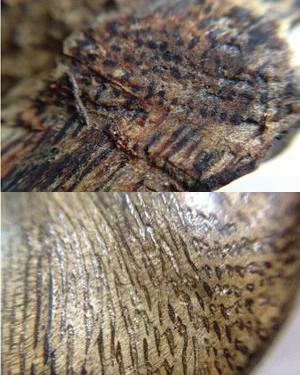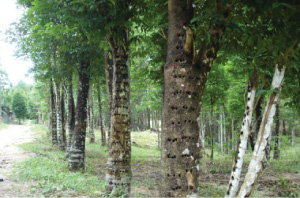NEWS & EVENTS > NEWS
"A nation's culture resides in the hearts and in the soul of its people"
-Mahatma Ghandi

The resin in the phloem of the hardwood are clearly manifest here as the darker lines and spots of the wood.
Chemicals and controls on artificial agarwood
The high demand of agarwood in China has led to a depletion of the wild resource. Though people generally prefer the natural agarwood over the artificial due to the rarity and value of natural agarwood, producing high quality artificial agarwood seems to be the only option satisfying the needs of the market. "With the help of modern biochemical and microscopic botany studies, researchers can find out ways to improve the odor of different kinds of agarwood, the composition of odor as well as the possibility of improving growth of artificial agarwood," said Hui.

A plantation of Aquilaria tree that have been artifically rendered to produce resin to create agarwood.
Even twenty years ago, China had neither the market interest (due to the economic status of the majority of its population), nor the financial resources to spend on scientific study focusing on the creation of artificial agarwood. But today's China tells a different story, and owners of plantations nowadays work together with professors and research institutions to learn to improve the conditions for cultivating more high quality artificial. The results may yet to be perfect, but they are continuous steps towards improvement.
Page 1 | 2
Related Links:
ENGLISH TRANSLATION:
"Tang Dynasty Incense archaeological discoveries" transcript
Xin Ge
PRESENTATION SLIDES:
"Tang Dynasty Incense archaeological discovieries"
Xin Ge
ENGLISH TRANSLATION:
"Han Dynasty Insense archaeological discoveries " transcript
Liu Hai Wang
PRESENTATION TRANSCRIP:
Han Dynasty Incense tradition
5 May 2015
PHOTOS:
Incense Conference 2015
VIDEOS:
Incense Conference 2015
"Tang Dynasty Incense archaeological discoveries" transcript
Xin Ge
PRESENTATION SLIDES:
"Tang Dynasty Incense archaeological discovieries"
Xin Ge
ENGLISH TRANSLATION:
"Han Dynasty Insense archaeological discoveries " transcript
Liu Hai Wang
PRESENTATION TRANSCRIP:
Han Dynasty Incense tradition
5 May 2015
PHOTOS:
Incense Conference 2015
VIDEOS:
Incense Conference 2015
